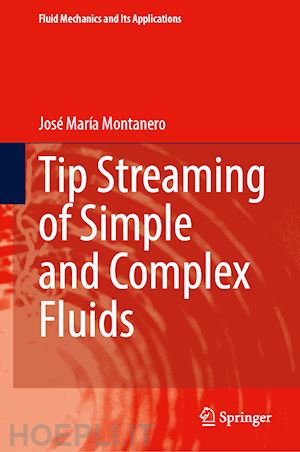

Questo prodotto usufruisce delle SPEDIZIONI GRATIS
selezionando l'opzione Corriere Veloce in fase di ordine.
Pagabile anche con Carta della cultura giovani e del merito, 18App Bonus Cultura e Carta del Docente
This book comprehensively describes the tip streaming in simple fluids and those containing surfactants and polymeric molecules. It summarizes the theoretical models and approximations commonly adopted to analyze this phenomenon. It provides relevant experimental results and presents the scaling laws for rationalizing those results. The stability of the flows leading to tip streaming is analyzed theoretically and experimentally. Attention is paid to the effects of surfactant monolayers and viscoelasticity, including solutocapillarity, interfacial elasticity, surface viscosity, and extensional thickening caused by the polymer coil-stretch transition.
It also offers an overall perspective of the numerous technological applications of the tip-streaming phenomenon. Remarkable examples are the production of microemulsions and microencapsulation of active agents for the food and pharmacy industries, the atomization of charged liquids for analytical chemistry, and the ejection of ultra-fast and ultra-thin jets for crystallography.
Physical mechanisms responsible for the onset of tip streaming driven by hydrodynamic and electrohydrodynamic forces are described. Relevant theoretical and experimental results of the periodic microdripping and continuous microjetting modes of tip streaming produced with microfluidic configurations such as electrospray, flow focusing, coflowing, and selective withdrawal are discussed. The physical mechanisms responsible for the instability of the microjetting mode are studied in detail.
The book collects the scaling laws used to predict the outcome of the microfluidic configurations mentioned above. The author combines state-of-the-art experimental results and linear stability analysis to identify the instability mechanisms limiting the applicability of the above-mentioned microfluidic configurations. In this way, the book connects experimental observations with fundamental aspects of tip streaming,bridging the microfluidic and fluid dynamicist communities. The connection between results obtained from the theoretical and experimental approaches will help experimentalists to understand the fundamental aspects of their practical problems. A useful guide for researchers working on hydrodynamic focusing and electrospray.
Introduction.- Governing equations.- Theoretical methods.- Experimental methods.- Electrohydrodynamic transient tip streaming.- Hydrodynamic transient tip streaming.- Microfluidic configurations for producing tip streaming.- Electrospray.- Coflowing and hydrodynamic focusing.- Gaseous flow focusing I.- Gaseous flow focusing II.
José María Montanero studied and received his Ph.D. in Physics at the University of Extremadura, Spain. Now, he is Professor of Fluid Mechanics and Head of the Department of Mechanical Engineering at the University of Extremadura. His primary research areas are microfluidics and surface tension-driven flows, considering both fundamental aspects and industrial and biotechnological applications in this field. He has published more than 170 articles in prestigious scientific journals and has received several research awards, including the Award for Excellence in Research Career at the University of Extremadura.











Il sito utilizza cookie ed altri strumenti di tracciamento che raccolgono informazioni dal dispositivo dell’utente. Oltre ai cookie tecnici ed analitici aggregati, strettamente necessari per il funzionamento di questo sito web, previo consenso dell’utente possono essere installati cookie di profilazione e marketing e cookie dei social media. Cliccando su “Accetto tutti i cookie” saranno attivate tutte le categorie di cookie. Per accettare solo deterninate categorie di cookie, cliccare invece su “Impostazioni cookie”. Chiudendo il banner o continuando a navigare saranno installati solo cookie tecnici. Per maggiori dettagli, consultare la Cookie Policy.